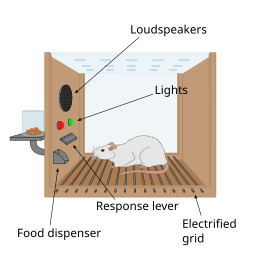
Back غرفة التكييف الفعال Arabic Skinner qutusu Azerbaijani Cambra de condicionament operant Catalan Skinner-Box German Cámara de condicionamiento operante Spanish Operantse tingimise kamber Estonian محفظه شرطیشدن فعال Persian Boîte de Skinner French תיבת סקינר HE Սկինների արկղ Armenian

An operant conditioning chamber (also known as a Skinner box) is a laboratory apparatus used to study animal behavior. The operant conditioning chamber was created by B. F. Skinner while he was a graduate student at Harvard University. The chamber can be used to study both operant conditioning and classical conditioning.[1][2]
Skinner created the operant conditioning chamber as a variation of the puzzle box originally created by Edward Thorndike.[3] While Skinner's early studies were done using rats, he later moved on to study pigeons.[4][5] The operant conditioning chamber may be used to observe or manipulate behaviour. An animal is placed in the box where it must learn to activate levers or respond to light or sound stimuli for reward. The reward may be food or the removal of noxious stimuli such as a loud alarm. The chamber is used to test specific hypotheses in a controlled setting.
- ^ Carlson NR (2009). Psychology-the science of behavior. U.S: Pearson Education Canada; 4th edition. p. 207. ISBN 978-0-205-64524-4.
- ^ Krebs JR (1983). "Animal behaviour. From Skinner box to the field". Nature. 304 (5922): 117. Bibcode:1983Natur.304..117K. doi:10.1038/304117a0. PMID 6866102. S2CID 5360836.
- ^ Schacter DL, Gilbert DT, Wegner DM, Nock MK (January 2, 2014). "B. F. Skinner: The Role of Reinforcement and Punishment". Psychology (3rd ed.). Macmillan. pp. 278–80. ISBN 978-1-4641-5528-4.
- ^ Kazdin A (2000). Encyclopedia of Psychology, Vol. 5. American Psychological Association.
- ^ Sakagami T, Lattal KA (May 2016). "The Other Shoe: An Early Operant Conditioning Chamber for Pigeons". The Behavior Analyst. 39 (1): 25–39. doi:10.1007/s40614-016-0055-8. PMC 4883506. PMID 27606188.
© MMXXIII Rich X Search. We shall prevail. All rights reserved. Rich X Search